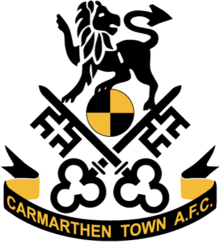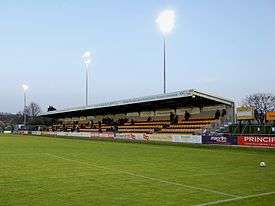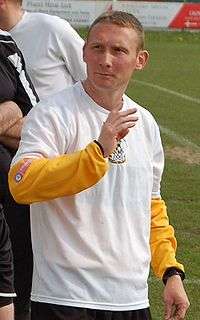Carmarthen Town A.F.C.
 | |||
| Full name | Carmarthen Town Association Football Club | ||
|---|---|---|---|
| Nickname(s) | Old Gold, The Town | ||
| Founded | 1950 | ||
| Ground |
Richmond Park Carmarthen | ||
| Capacity | 3,000 (1,000 seated) | ||
| President | Einsley Harris | ||
| Chairman | Jeff Thomas[1] | ||
| Manager | Mark Aizlewood | ||
| League | Welsh Premier League | ||
| 2015–16 | Welsh Premier League, 7th | ||
| Website | Club home page | ||
|
| |||
Carmarthen Town Association Football Club (Welsh: Clwb Pêl-droed Tref Caerfyrddin) is a Welsh semi-professional football club based in Carmarthen. The team play their home games at Richmond Park. The club colours, reflected in their crest and kit, are gold and black.
Formed in 1950, Carmarthen Town was elected into the Welsh Football League in 1953. Their first league honour came in 1959–60, with promotion from Division 2 West to the First Division of the Welsh League. Carmarthen Town's first trophy was the Welsh Football League Cup, which they won in the 1995–96 season. Since then the club have gone on to win the Welsh Cup once and the Welsh League Cup twice. They have also qualified for UEFA competitions on four occasions.
Carmarthen Town currently play in Welsh Premier League and have yet to win a league title, despite being in the top tier of Welsh football since 1996–97. The club had their highest-ever finish in 2000–01, with third place, which qualified them for European competition for the first time.
History
The first attempt to form a Carmarthen Town team came in 1920. Jack Harding, a Geordie who settled in the town and had previously played in the Wearside League, made his initial effort in order to give other local sides more competition. The club only lasted for three years. Jack then went on to play for the St.Peter's and Quay Rovers (a Carmarthen team in all but name) clubs both of which folded in 1939. After the Second World War he founded a Carmarthen Athletic team but the players were not fully committed. In fact one match had to be called off as most of the team were engaged in bell ringing on a Saturday. However, he was more successful in 1950 when forming Carmarthen Town and he made some shrewd signings from Llanelli and Swansea Town. The club played their first two seasons at Penllwyn Park and in 1952 moved to the newly created Richmond Park. A year later an application to join the Welsh League was successful with the new captain, Len Emanuel, taking over the reins. The stated aim of the club was "to give the public good football," and they succeeded in attracting crowds of over three thousand to home games. With only one team gaining promotion from the Second Division (West) the club finally achieved success in 1960 following five seasons as league runners-up. Alas, relegation followed twelve months later. It took four further years to win promotion again. The years passed with mediocre league placings and in 1976 the club looked like folding. It was the disbanded reserve team's committee which came to the fore and took over the running of the whole club. Relegation came again in 1979 and again in 1982. Things were grim. At long last promotion was achieved in 1992, and once more in 1995. The upward surge continued and the Welsh League Championship was won in 1996 along with the Welsh League Cup. The Old Gold were now in the League of Wales. The 1996–97 season was one of consolidation. Early in the following season, in September 1997, Carmarthen attracted a record league crowd of 911 to their match against Barry Town. The season's club captain, Mark Delaney would go on to establish himself in England at Premier League club Aston Villa. In May 1999 the Old Gold reached the Welsh Cup Final (losing on penalties) and the following year were runners-up in the Welsh Senior Cup. In 2001 Carmarthen finished third in the league and so qualified for a European competition for the first time. A 0–0 home draw against the Swedish side AIK Stockholm in the UEFA Intertoto Cup was followed by a 3–0 loss in the return leg. The appointment of Mark Jones as manager in the summer of 2004 stopped a slide which had seen the club fail to build on their European experience. Within twelve months the club were again in Europe having qualified as losing finalists in the Welsh Cup. Carmarthen were drawn against League of Ireland club Longford Town and were beaten 2–0 in the away leg. A fortnight later came the highest point in the club's history when they thrashed the Irishmen 5–1 to achieve the highest score by any Welsh club in European competition. The second Qualifying Round saw 2–0 defeats in both legs against Danish side FC Copenhagen. Fourth place in the league in 2006 saw the club gain a second season of European football but, again, defeat in both legs, this time against Finnish club Tampere United ensured there was no repeat of the previous season's euphoria. The 2006–07 season saw the club win the Welsh Cup for the first time which meant more European matches. However, the Norwegian club SK Brann were far too strong for the Old Gold over both legs. The next two seasons saw little success and with the now renamed Welsh Premier League due to be restructured after the end of the 2009–10 season it was imperative that Carmarthen finished in the top twelve to retain their status. They narrowly succeeded. The club's first season in the revamped league was inconsistent and in January 2012, former coach Mark Aizlewood was appointed as manager in an attempt to save the club from relegation. With some new signings he managed the virtually impossible and the following summer changed the vast majority of the team's personnel. This resulted in the club having its best season for many years. The League Cup success against The New Saints on a cold January day in Newtown was followed by qualification for the WPL Championship Conference and an automatic Europa League qualifying semi-final match. The League Cup was won again in January 2014 when Bala Town were defeated. For the 2014–15 season Aizlewood and coach, Neil Smothers, have brought in a few new faces to add to the squad. In February 2014, Carmarthen Town played their 600th Welsh Premier League match which is a far cry from that initial 1950–51 season.
Stadium

Main article(s): Richmond Park (Carmarthen)
From 1952 Carmarthen Town have played at Richmond Park in Carmarthen. The ground has been redeveloped over recent years into a small, modern and compact football stadium with a capacity of 3,000. The club's new Clay Shaw Butler Stand has a 1000-seat capacity which enabled Carmarthen Town to host the club's first ever home European fixture at the ground in July 2007 when they entertained Norwegian side SK Brann.
Supporters
In the 2012–13 season Carmarthen's average attendance was 296, placing them fourth out of twelve teams in the Welsh Premier League. The highest league gate of the season came against Afan Lido FC with 413 spectators and the lowest, 167, against Airbus UK Broughton. [2]
Current squad
- As of 30 August 2016.[3]
Note: Flags indicate national team as defined under FIFA eligibility rules. Players may hold more than one non-FIFA nationality.
|
|
Club officials

- Senior club staff
- President: Einsley Harris
- Chairman: Chris Edwards
- Club Secretary & Football Administrator: Peter Price
- Press Officer: Rob Lloyd
- Coaching and medical staff
- Manager: Mark Aizlewood
- Assistant Manager: Neil Smothers
- Player/Coach: Danny Thomas
- Physiotherapist: Richard Brook
Managerial history
The following managers have each been in charge of Carmarthen Town since the club gained promotion to the highest tier in Welsh football, the Welsh Premier League, in 1996.
As of January 2014
| Name | Nationality | Period | Honours | |
|---|---|---|---|---|
| From | To | |||
| Wyndham Evans | January 1996 | October 1996 | Welsh Football League Cup Winner | |
| John Mahoney | October 1996 | November 1998 | ||
| Tomi Morgan | November 1998 | 24 September 2003[6] | Welsh Cup Runner-up, Highest ever League position: 3rd place 2000–01 | |
| Andrew York | 24 September 2003[6] | May 2004 | Welsh League Cup Runner-up | |
| Mark Jones | 12 May 2004[7] | 22 May 2007[8] | Welsh Cup Winner, Welsh Cup Runner-up, Welsh League Cup Winner | |
| Deryn Brace | 23 May 2007[8] | 8 June 2010[9][10] | ||
| Tomi Morgan | 8 June 2010[9] | 5 December 2011[11] | ||
| Neil Smothers | 5 December 2011[11] | 7 January 2012[12] | ||
| Mark Aizlewood | 7 January 2012[12] | Present | Welsh League Cup Winner (2): 2012–13, 2013–14 | |
Honours
- As of 10 January 2014.[13]
The Welsh Football League
- Welsh second tier (currently Welsh Football League Division One)
- Winners (1): 1995–96
- Welsh third tier (currently Welsh Football League Division Two)
- Winners (1): 1959–60
Domestic Cup Competition
- Welsh Cup:
- Winners (1): 2006–07
- Runners-up (2): 1998–99, 2004–05
- Welsh Premier League Cup:
- Welsh Football League Cup
- Winners (1): 1995–96
- West Wales Senior Cup:
- Winners (1): 2004
- Runners-up (2): 2003, 2006
European Competition
Records
- As of 3 August 2013.[14]
Record wins
- Record league win: 9–1 against UWIC Inter Cardiff, 21 October 2000
- Record league home win:
- 9–1 against UWIC Inter Cardiff, 21 October 2000
- 8–0 against Cardiff Grange Quins, 10 December 2005
- 8–0 against Connah's Quay Nomads, 8 December 2007
- Record league away win: 7–1 against Caersws, 6 October 2006
Record defeats
- Record league defeat: 0–8 against The New Saints, 29 March 2009
- Record league home defeat:
- 1–5 against Bangor City, 7 December 1996
- 0–4 against Aberystwyth Town, 26 February 1997
- 0–4 against Ton Pentre, 4 September 1996
- 0–4 against Haverfordwest County, 8 December 2000
- Record league away defeat: 8–0 at The New Saints, 29 March 2009
Player records
- Most goals in season:
- 18 by Danny Thomas in 2007–08
- 18 by Richard Parker in 1999-00
- Most goals in match: 5 by Tim Hicks against Connah's Quay Nomads, 8 December 2007
- Club top scorer: 56 by Danny Thomas from 116 appearances (+41 substitute appearances)
- Most club appearances: 199 (+12 substitute appearance) by Paul Fowler
European record
- Record European win: 5–1 against Longford Town, 28 July 2005
- Record European defeat: 0–8 against SK Brann, 19 July 2007
- Carmarthen Town's scores are given first in all scorelines.
| Season | Competition | Round | Opponent | Home | Away | Aggregate | Refs |
|---|---|---|---|---|---|---|---|
| 2001–02 | UEFA Intertoto Cup | First round | |
0–0 | 0–3 | 0–3 | [15] |
| 2005–06 | UEFA Cup | First qualifying round | |
5–1 | 0–2 | 5–3 | [16] |
| Second qualifying round | |
0–2 | 0–2 | 0–4 | [16] | ||
| 2006 | UEFA Intertoto Cup | First round | |
1–3 | 0–5 | 1–8 | [17] |
| 2007–08 | UEFA Cup | First qualifying round | |
0–8 | 3–6 | 3–14 | [18] |
See also
List of Carmarthen Town A.F.C. seasons
References
- ↑ "club Details". welshpremier.co.uk. The Football Association of Wales.
- ↑ "Welsh Premier League Report Season 2012–13" (PDF). Soccerfile Wales. Retrieved 3 August 2013.
- ↑ http://www.welshpremier.co.uk/players/Carmarthen/2016/2017/p/Position
- ↑ "FAW WPL Team Page". welshpremier.com. The Football Association of Wales. Retrieved 7 June 2013.
- ↑ "Carmarthen Town Staff & Squad 2012–13". carmarthentownafc.com. Carmarthen Town AFC. Archived from the original on 14 April 2013. Retrieved 7 June 2013.
- 1 2 "Morgan pays price for poor start". bbc.co.uk. BBC Sport. 24 September 2003. Retrieved 3 August 2013.
- ↑ "Jones takes Carmarthen helm". bbc.co.uk. BBC Sport. 12 May 2004. Retrieved 3 August 2013.
- 1 2 "Brace in for Jones at Carmarthen". bbc.co.uk. BBC Sport. 23 May 2007. Retrieved 3 August 2013.
- 1 2 "Tomi Morgan appointed Carmarthen Town boss". bbc.co.uk. BBC Sport. 8 June 2010. Retrieved 3 August 2013.
- ↑ "Town boss Deryn steps down". thisissouthwales.co.uk. Local World. 9 June 2013. Retrieved 3 August 2013.
- 1 2 "Carmarthen replace manager Tomi Morgan with Neil Smothers". bbc.co.uk. BBC Sport. 5 December 2011. Retrieved 3 August 2013.
- 1 2 "Aizlewood handed task of saving Carmarthen". welshpremier.co.uk. The Football Association of Wales. 7 January 2012. Retrieved 3 August 2013.
- ↑ "Carmarthen Town Club History". fchd.info. Football Club History Database (F.C.H.D.). Retrieved 3 August 2014.
- ↑ "Carmarthen Town Club Profile". welsh-premier.com. Welsh Premier Football. Retrieved 3 August 2013.
- ↑ "UEFA Intertoto Cup 2001". rsssf.com. Rec.Sport.Soccer Statistics Foundation (RSSSF). Retrieved 3 August 2013.
- 1 2 "2005/06 UEFA Cup Carmarthen Town Results". uefa.com. Retrieved 6 June 2013.
- ↑ "UEFA Intertoto Cup 2006". rsssf.com. Rec.Sport.Soccer Statistics Foundation (RSSSF). Retrieved 3 August 2013.
- ↑ "2007/08 UEFA Cup Carmarthen Town Result". uefa.com. Retrieved 6 June 2013.
External links
- Official websites
- Official website
- Carmarthen Town at the Welsh Premier League official website
- Carmarthen Town at the UEFA official website
- News sites
- Carmarthen Town at the unofficial Welsh Premier League website
- Other